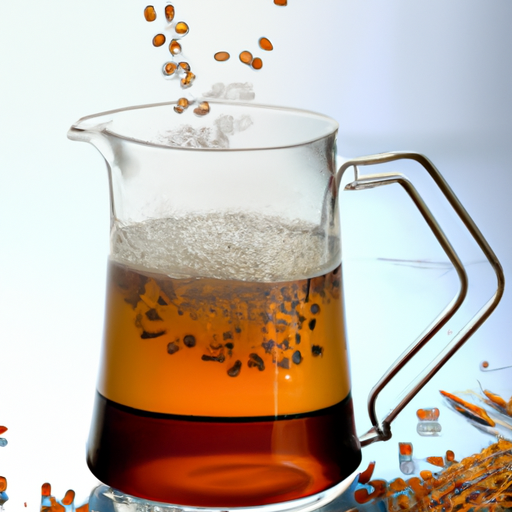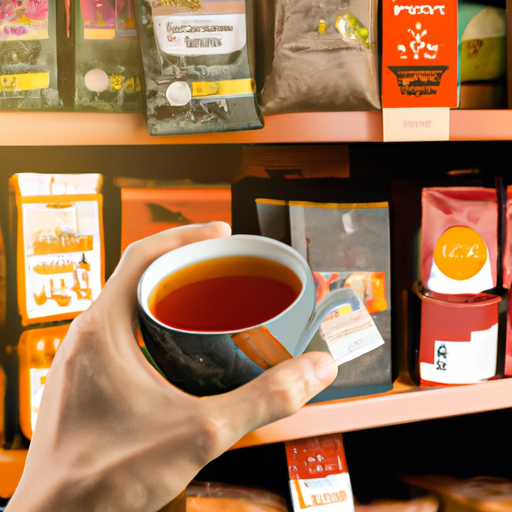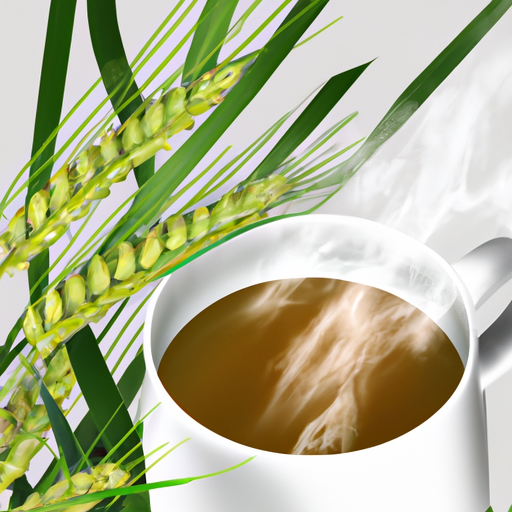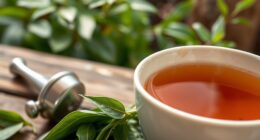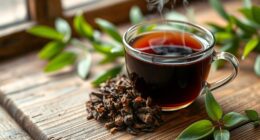As someone with a deep appreciation for tea, the diverse range of tea types globally has always captivated me. Not long ago, I came across Korean barley tea and found myself drawn to its distinctive taste and health advantages. This prompted me to take it upon myself to master the brewing process for this particular tea.
Korean barley tea, also known as Boricha, is a caffeine-free tea made from roasted barley grains. It has a nutty flavor with subtle hints of sweetness and is often consumed hot or cold as a refreshing beverage throughout the day.
In this article, I will share my step-by-step guide on how to brew Korean barley tea at home using both loose leaves and tea bags.
Key Takeaways
- Korean barley tea is a caffeine-free tea made from roasted barley grains with a nutty flavor and subtle sweetness.
- It is brewed with two simple ingredients: roasted barley grains and water, with optional sweeteners, and can be served hot or cold.
- Korean barley tea offers a range of health benefits, such as aiding digestion, promoting relaxation, and protecting against inflammation and oxidative stress.
- Korean barley tea has cultural significance in Korea, where it is seen as a gesture of hospitality and respect to serve guests with the tea.
Overview of Korean Barley Tea
If you’re looking for a refreshing and nutty-tasting beverage, Korean barley tea is a must-try! This tea has been enjoyed in Korea for centuries and holds cultural significance. It’s often served as a welcoming drink to guests or offered as an after-meal digestif.
History tells us that during the Joseon Dynasty, barley was considered a staple crop and was used for both food and beverages. Barley tea became popular because of its health benefits, such as aiding digestion and promoting relaxation. Today, it remains a beloved drink in Korean culture.
To brew this delicious tea at home, you’ll need just two simple ingredients: roasted barley grains and water. It’s incredibly easy to make – simply steep the roasted barley grains in hot water for several minutes until the desired strength is reached. You can add sweeteners like honey or sugar if you prefer, but traditionally it’s enjoyed without any added flavors.
Now that we know the history and cultural significance of Korean barley tea, let’s move on to the key ingredients needed for brewing this delightful beverage.
Ingredients Needed for Brewing
To brew Korean barley tea, you’ll need three key ingredients: roasted barley grains, water, and optional ingredients.
The roasted barley grains are the main ingredient that gives the tea its nutty flavor and aroma. Water is essential to extract the flavor from the grains and create a soothing drink.
Optional ingredients, such as sugar or honey, can be added to sweeten the tea to your liking.
Roasted Barley Grains
Roasted barley grains are a key ingredient in Korean barley tea, adding a nutty and toasty flavor to the brew. Not only do they provide a delicious taste, but they also offer numerous health benefits. Barley is high in fiber, which aids digestion and helps regulate blood sugar levels. It also contains antioxidants that can help protect against cancer and other diseases.
In addition to its health benefits, roasted barley is commonly used in Korean cuisine for its unique flavor. It can be added to soups or stews for an earthy taste, or sprinkled on top of rice dishes for added texture. However, when it comes to brewing Korean barley tea, the roasted grains take center stage as the star ingredient that gives the beverage its distinct aroma and taste. Moving onto the next step, one must consider the quality of water used for brewing this delectable drink.
Water
Water is an essential component in creating a refreshing and flavorful Korean barley tea. Different types of water can affect the taste of your tea, so it’s important to choose wisely.
Filtered or purified water is recommended as it will produce a clean and pure taste without any added minerals or chemicals. The temperature level of the water also plays a crucial role in brewing Korean barley tea.
The ideal temperature for steeping roasted barley grains is between 175-185°F (80-85°C). Boiling water may make the tea bitter, while using water that’s too cold won’t fully extract the flavors and aromas from the roasted barley grains.
Once you have brewed your tea with just water, you can now add optional ingredients to enhance its flavor profile.
Optional Ingredients
You can add a splash of lemon juice or a sprig of fresh mint to give your barley tea a zesty and refreshing twist, like adding a burst of sunshine on a breezy day. These optional ingredients not only enhance the flavor of the tea but also offer additional health benefits. Lemon juice is known for its detoxifying properties while mint aids in digestion and provides relief from nausea.
Here are some other flavor variations you can try with your Korean barley tea:
| Optional Ingredients | Flavor Profile | Health Benefits |
|---|---|---|
| Ginger | Spicy | Aids in digestion and relieves nausea |
| Honey | Sweet | Soothes sore throat and coughs |
| Cinnamon | Warm | Lowers blood sugar levels |
Now that we’ve explored some tasty ways to jazz up your barley tea, let’s move on to preparing the tea bags or loose leaves.
Preparing the Tea Bags or Loose Leaves
First, grab your chosen tea bag or loose leaves and place them in a teapot or mug. If you prefer a stronger flavor, then go for a loose leaf variety as it contains whole grains that release more flavor when infused with hot water. On the other hand, tea bags are convenient and easy to use – perfect for those who are always on-the-go.
When choosing barley tea, take note of the different types of barley used as it can affect the taste and aroma of your brew. Loose leaf vs tea bags: which one should you choose? It really depends on your preference and lifestyle. Loose leaf varieties offer a stronger flavor profile but require more time to prepare compared to tea bags. The latter offers convenience and ease especially if you’re in a hurry or have limited space in your kitchen.
Whichever you choose, make sure to store them properly in an airtight container away from sunlight, heat, and moisture. Now that you have chosen the type of barley tea that suits your taste buds best, it’s time to prepare them for brewing. Simply place your preferred amount of tea bag or loose leaves into a teapot or mug. If using loose leaves, make sure to strain them before pouring onto your cup.
Next up is the brewing process – stay tuned!
Brewing Process
Now that I’ve prepared my tea bags or loose leaves, it’s time to brew them.
There are two main methods for brewing tea: boiling and steeping. The boiling method involves bringing water to a boil and pouring it over the tea. The steeping method requires letting the tea sit in hot water for a certain amount of time.
Both methods have their advantages and disadvantages, so it’s important to choose the one that works best for your preferences and the type of tea you’re brewing.
Boiling Method
To get the water hot enough for brewing, simply pop it in the microwave and let it heat up until steam is rising from the surface – it’ll be hotter than the sun! Boiling is a common method used to brew Korean barley tea. One of the benefits of boiling is that it extracts more flavor and aroma from the barley grains compared to other brewing methods. Additionally, boiling helps to kill any bacteria or germs that may be present in the water.
Here’s a table that summarizes the steps for boiling Korean barley tea:
| Steps | Instructions |
|---|---|
| 1 | Add barley tea leaves into a pot with cold water (ratio: 1:10) |
| 2 | Place pot on stove and bring to a boil over high heat |
| 3 | Once boiling, reduce heat to low and let simmer for 15-20 minutes |
| 4 | Remove from heat, strain out tea leaves, and serve hot or chilled |
Next, we’ll go over another popular brewing method – steeping.
Steeping Method
When using the steeping method, you can simply let your tea leaves soak in hot water for a few minutes to extract their full flavor. This alternative steeping method is perfect for those who want to enjoy a more delicate and nuanced flavor profile from their barley tea.
Unlike the boiling method which can result in a stronger and slightly bitter taste, steeping allows you to appreciate the subtle sweetness of barley tea. Moreover, this method also offers various flavor variations depending on how long you steep the tea leaves.
For instance, if you prefer a milder taste, you can steep the tea for only 2-3 minutes. On the other hand, if you want a stronger and bolder taste, let it sit for 5-10 minutes before straining it. By adjusting the length of time that you leave your barley tea to soak in hot water, you can personalize your brew according to your specific preferences without compromising its overall quality and essence.
Adjusting the Strength of the Tea
If you’re looking for a stronger cup of Korean barley tea, simply let the tea steep for a few more minutes before serving. Adjusting tea strength is all about finding your perfect balance between flavor and intensity. This method is perfect for those who prefer a bolder taste or have a higher tolerance for caffeine.
To adjust the tea strength, start by monitoring the color of the brew. A darker hue indicates a stronger cup while lighter shades are milder in taste. If you’re not satisfied with the color after steeping, try increasing the amount of barley leaves per cup or extending the brewing time by an additional 1-2 minutes until you reach your desired level of potency.
With these tips, you can make sure that every sip of your Korean barley tea is just how you like it – full-bodied and flavorful.
Now that we’ve adjusted our strength to perfection, let’s move on to serving suggestions to make this drink even more enjoyable!
Serving Suggestions
Now that you know how to adjust the strength of your Korean barley tea, it’s time to talk about serving suggestions. Personally, I enjoy drinking my barley tea hot, especially during the colder months. However, there are many ways to serve this delicious beverage.
One great way to enjoy Korean barley tea is by pairing it with traditional Korean snacks such as rice cakes or savory pancakes. The slightly nutty flavor of the tea complements these dishes perfectly and helps cleanse your palate between bites. Additionally, barley tea can also be served chilled in the summer months for a refreshing and healthy alternative to sugary drinks.
Speaking of health benefits, did you know that Korean barley tea is packed full of antioxidants and has been known to aid in digestion? It’s true! Not only does this beverage taste great but it also has numerous health benefits that make it a wonderful addition to any diet.
So whether you prefer your Korean barley tea hot or cold, paired with snacks or enjoyed on its own for its health benefits, there are many ways to serve this versatile drink. Now let’s move on to the next section where we’ll discuss how best to store your leftover tea.
Storing the Tea
To maximize the freshness and flavor of your beloved Korean barley tea, you should store it in an airtight container. Here are some storing tips to ensure that your tea stays fresh for a longer period:
- Store the tea in a cool, dry place away from direct sunlight.
- Keep the tea away from strong-smelling items like spices or coffee as they can affect the aroma and flavor of the tea.
- Once opened, use up the tea within six months to avoid loss of flavor.
- If you want to store the tea for a longer time, you can freeze it in an airtight container.
By following these simple storing tips, you can increase the shelf life of your Korean barley tea and enjoy its refreshing taste for several months.
Now that we’ve covered how to store Korean barley tea properly, let’s move on to other uses for this versatile beverage.
Other Uses for Korean Barley Tea
Picture yourself sitting outside on a hot summer day, sipping on a refreshing beverage that not only quenches your thirst but also aids in digestion and helps alleviate bloating – Korean barley tea can do just that! This tea has been used for centuries in Korea as a medicinal drink due to its numerous health benefits. For one, it is rich in antioxidants that help protect the body from free radicals. It also contains fiber which aids in digestion and helps regulate blood sugar levels.
Aside from its health benefits, Korean barley tea is also versatile in the culinary world. It can be used as a base for soups or stews, as well as an ingredient for baked goods such as breads and muffins. Some people even use it as a marinade for meats or fish before grilling or roasting to add flavor and impart some of the tea’s health benefits into their dishes.
Korean barley tea is not just limited to being a refreshing drink during hot weather. Its numerous health benefits and culinary uses make it an excellent addition to anyone’s pantry. In the next section, we will compare Korean barley tea to other types of tea to see how they differ in taste and nutrition content.
Comparison to Other Types of Tea
Get ready to discover how Korean barley tea stacks up against other popular types of tea in terms of taste and nutritional value. When comparing flavor, Korean barley tea has a unique nutty and slightly sweet taste that sets it apart from other teas like green or black teas which are more bitter and astringent.
Additionally, Korean barley tea is naturally caffeine-free, making it an ideal choice for those who want to avoid caffeine but still enjoy the soothing ritual of drinking tea.
In terms of health benefits, Korean barley tea is often touted for its high fiber content which can aid in digestion and promote feelings of fullness. It also contains antioxidants that can help protect against inflammation and oxidative stress in the body. While other teas like green or black teas have their own set of health benefits, they may also contain caffeine which can be harmful to some individuals with certain health conditions.
Traditional Korean barley tea ceremonies and etiquette add another layer to the overall experience of drinking this type of tea. In Korea, serving guests with barley tea is seen as a gesture of hospitality and respect. The preparation process involves boiling water with roasted barley grains before straining out the grains to serve the resulting nutty liquid hot or cold.
Drinking from small cups while holding them with both hands is customary during these ceremonies as a sign of appreciation for the host’s efforts in preparing the beverage.
Frequently Asked Questions
How long can you store brewed Korean barley tea in the refrigerator before it goes bad?
When it comes to storing brewed Korean barley tea, there are a few things to keep in mind. First and foremost, it’s important to use a proper container for storage. This can be an airtight glass jar or bottle that will help preserve the tea’s freshness.
As for shelf life, you can expect your brewed barley tea to last around 3-5 days in the refrigerator before it starts to lose its flavor and aroma. To extend its shelf life, consider using preservation methods like freezing or canning.
When freezing the tea, make sure to pour it into an ice cube tray and cover with plastic wrap before placing it in the freezer. Properly stored, frozen Korean barley tea cubes can last up to six months without losing their quality.
Overall, if you want to enjoy your brewed Korean barley tea at its best for as long as possible, be sure to follow these simple storage tips and preservation methods!
Can you add honey or other sweeteners to Korean barley tea?
When it comes to sweetening options for Korean barley tea, there are a few different routes you can take. Personally, I enjoy adding a drizzle of honey to my cup for a touch of sweetness. Other options could include agave nectar or maple syrup.
It’s important to note that the nutty flavor of the barley tea pairs well with earthy sweeteners like these. If you’re looking for more creative flavor pairings, consider adding a splash of coconut milk or almond milk to your tea instead of traditional dairy creamer.
Overall, there are plenty of ways to customize your Korean barley tea and make it feel like your own!
What are the health benefits of drinking Korean barley tea?
What are the health benefits of drinking Korean barley tea? I often get asked this question, and for good reason. Not only is it a delicious beverage, but it also has numerous nutritional benefits.
Barley tea is an excellent source of antioxidants, which can help to prevent cell damage and reduce the risk of chronic diseases such as cancer and heart disease. It is also rich in vitamins and minerals like vitamin B1, magnesium, and selenium.
In terms of flavor profile, Korean barley tea has a nutty and slightly sweet taste that pairs well with many dishes. Preparation techniques can vary depending on personal preference, but boiling water over roasted barley grains or using pre-made teabags are common methods. There are even variations such as adding ginger or lemon to enhance the taste and provide additional health benefits.
Overall, drinking Korean barley tea is not only enjoyable but also provides numerous benefits for your health.
Can you reuse the tea bags or loose leaves to make a second batch of tea?
When it comes to reusing tea bags or loose leaves for a second batch of Korean barley tea, my answer is a bit mixed.
On one hand, reusing tea bags or leaves can save money and reduce waste. However, the second steeping may not be as flavorful or potent as the first.
It also depends on personal preference – some people might find the taste too weak and not worth the effort of brewing again.
Overall, I’d say it’s up to individual taste and preference whether they want to reuse their tea bags or loose leaves for a second batch of Korean barley tea.
Can you make Korean barley tea using a coffee maker or French press?
Using alternative methods to make Korean barley tea, such as a coffee maker or french press, may alter the taste compared to traditional brewing. However, it’s possible to experiment with different brewing techniques and find a method that works best for your taste preferences.
When using a coffee maker or french press, it’s important to consider the strength of the tea and adjust accordingly by either adding more or less barley and water. These methods may not provide the same depth of flavor as traditional brewing, but they can still be convenient options for those who don’t have access to a stove or prefer a quicker process.
Ultimately, taste comparison will vary depending on personal preference, and experimentation is key in finding what works best for you.
Conclusion
In conclusion, brewing Korean barley tea at home is a simple process that yields a delicious and refreshing beverage. With just a few ingredients and some basic steps, anyone can enjoy this traditional Korean drink in the comfort of their own home.
As the saying goes, "a cup of tea a day keeps the doctor away,"and Korean barley tea is no exception. Not only is it tasty, but it also has several health benefits, such as aiding digestion and reducing inflammation.
Whether enjoyed hot or cold, this versatile beverage can be customized to suit any taste preference. So why not give it a try? Brewing your own Korean barley tea is an easy way to explore new flavors and cultures while reaping the many benefits of this beloved drink.

